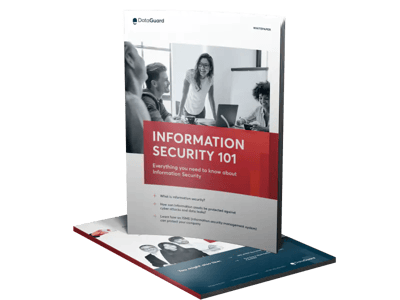You protect and maintain the confidentiality, integrity and availability of information through information security. It's your effective and ethical way to protect all types of information, providing guidelines to ensure privacy, prevent unauthorised access, minimise risk and maintain confidentiality.
Your company's information security policy ensures that you and your employees adhere to minimum standards of privacy and IT security.
Creating an information security policy guides you on how to handle sensitive information and protect data such as credit card numbers, social security numbers, or bank account details.
In this article, you'll learn what an information security policy is, its purpose, what it should contain, and why it's important for you to have one.
In this article
- What is an information security policy?
- What are the three principles of information security?
- What is the purpose of information security policy?
- What should you include in an information security policy?
- What is the importance of an information security policy?
- What are the 12 Elements of an Information Security Policy?
- How does ISO 27001 tie into information security policy?
- Conclusion
What is an information security policy?
Information security policies are a crucial component of any data protection plan. They establish a framework for protecting information assets and ensure that the organisation is working in accordance with industry standards and regulations.
This policy serves as a guideline for all employees to follow when storing, processing or transmitting sensitive data. It outlines what kind of information an employee should not disclose or share with others, such as passwords or personal details.
It also defines how employees should behave if they are asked to provide confidential data by third parties such as clients or vendors. The policy ensures that individuals who meet these criteria will be protected from potential harm or embarrassment, while also fulfilling their obligations under law.
Employees should always be aware of what is required by their employer and adhere to it at all times, or risk being held accountable for any breaches in security measures implemented by them on behalf of the organisation.
Now that you have understood what an information security policy means, let us take a look at the three principles information security is based on.
What are the three principles of information security?
Confidentiality, integrity and availability (CIA) are the three principles of information security. These principles ensure that your data is secure and protected from unwanted access.
- Confidentiality: The confidentiality principle ensures that information is protected from unauthorised access, use or disclosure. This means that information should only be accessed by authorised people and systems, who have a need to know what you're sending them and how it can be used for their own purposes.
- Integrity: The integrity principle ensures that your data remains accurate and unchanged if it is accessed by anyone with whom you've shared it. This means you should keep track of any changes to your data as they happen, so that it remains consistent with its original form in case someone attempts to change it later on.
- Availability: The availability principle ensures that users can access their data when they need it, whether that's through automatic backups or manual syncing between devices or users.
What is the purpose of information security policy?
The main goal of an information security policy is to describe what information is considered "sensitive," what types of systems it is stored on, how it should be protected, and who gets access to it. The policies also outline what happens if sensitive data is lost or stolen.
A good policy should include guidelines for employees about how they can protect themselves from becoming victims of identity theft, including using passwords that are long enough (at least 15 characters) and difficult enough to remember, changing them regularly, and not storing sensitive personal information on organisation computers or devices that are not password protected or encrypted.
In addition, policies should outline how employees can report breaches if someone else has accessed sensitive information without permission and how quickly they should do so. Policies should also include details about what happens if employees violate these rules from disciplinary action to termination.
What should you include in an information security policy?
Policies should provide relevant details about the organisation and its procedures. You should start by including the following sections:
- Scope: Make sure you include the scope of your data and the type of information that needs to be protected. The more specific you can be, the better.
- Policy statement: This section outlines the mission of your organisation and its responsibilities to protect data, monitor and maintain compliance with this policy, and report any breaches or suspicious activity to appropriate authorities. It should also include a description of how employees will be held accountable for their actions, as well as how they are notified when there is a breach.
- Objectives: List any goals you have for your information security program, as well as any specific objectives that relate directly to best practices in the industry or that are otherwise required by law or regulation. This section should also include details on how your organisation measures success against these goals and objectives, as well as what metrics it will use to evaluate performance against those goals and objectives over time so that it can make adjustments as necessary throughout its existence.
What is the importance of an information security policy?
Information security policies are important because they help you to protect your organisation's data and confidential information.
When you create a policy, you are setting out rules for how employees should handle personal information. You can also include procedures for reporting any breaches of security or incidents that compromise the confidentiality of personal information.
This means that you do not need to worry about your employees accidentally sharing personal information with someone else or allowing it to be accessed by an unauthorised person. You can rest assured knowing that your organisation's data is safe from any potential threats.
What are the 12 Elements of an Information Security Policy?
A security policy can be as comprehensive as you like, including all aspects of IT security and the protection of associated physical assets, but it must be fully enforced. Some crucial factors to take into account while creating an information security policy are provided in the list below.
- State the purpose
The purpose of an information security policy is to outline the rules and regulations for how your organisation handles information. It should provide clear guidance on how employees can use and share confidential information, as well as how they should secure it from external threats.
- Define your audience
Your information security policy should be tailored to fit the needs of your organisation and its employees, whether you are a small start-up or a large enterprise with thousands of employees. If it is not clear who will be reading your policy and how they will use it, then it is probably not very useful.
- Set your Information security objectives
Your information security objectives should be clear and concise. They should be easy to understand without being overly technical or complicated. You do not want to scare off new hires by writing something too complex. Instead, try using simple language that anyone can understand with minimal effort.
- Set up authority and access control policy
This section of your policy details who has authority over what parts of the network, such as servers or workstations or both. Allowing only authorised users into these areas helps prevent unauthorised access from outside sources such as hackers.
- Set up Data classification
The first element of any information security policy is data classification. You must classify your data so that only authorised personnel can access it. This includes all types of files and databases, including those in the cloud or stored on external devices.
- Set up Data support and operations
The second element of an information security policy is data support and operations. This includes network monitoring, intrusion detection systems (IDS), web application firewall (WAF) software, and other tools that provide protection against unauthorised access to sensitive data.
- Set up security awareness and behaviour
This includes educating employees about what constitutes a threat to their system, how to recognize one, and what they can do if one is detected. It also involves training them on how not to be infected by malware or phishing attacks.
- Set up encryption policy
The fourth element of any information security policy is encryption policy. The process by which encrypted data is transmitted over insecure channels such as email or the Internet. This ensures that sensitive information cannot be accessed without authorisation by anyone who does not have access.
- Data backup policy
A data backup policy is a set of rules and procedures that indicate how an organisation will store its data and how long it will be stored for. This can include the storage media, location, retention period, and number of copies kept onsite or offsite.
- Responsibilities, rights, and duties of personnel
This section includes information about who has access to systems and who is responsible for keeping them secure from threats. It also states who has the authority to make decisions regarding security measures and what those leaders should do if there are issues with compliance with standards or regulations.
- System hardening benchmarks
The system hardening benchmark section includes requirements for servers and operating systems that must be met before they can be used by employees or contractors, such as ensuring they meet minimum security standards and have appropriate patches installed on them. The benchmark also includes requirements for network devices like routers and switches so they are secured against threats before they are connected into a network's infrastructure.
- References to regulations and compliance standards
Regulations and compliance requirements that have an influence on the organisation, such as GDPR, CCPA, PCI DSS, SOX, and HIPAA, should be mentioned in the information security policy.
References to relevant laws or certifications that the organisation is working within or toward, such as the ISO 27001 certification, should be included in the information security policy.
How does ISO 27001 tie into information security policy?
Annex A.5 of ISO 27001 provides guidelines for how businesses can implement information security policies. Annex A.5 controls explain how information security policies should be handled.
ISO 27001 standard was developed to help organisations understand what they need to do to manage information security. It sets out specifications for an information security management system (ISMS) which enables companies to secure information of all forms.
Conclusion
The goal of Information Security Policy is to protect the confidentiality, integrity, and availability of an organisation’s and its users' data. A secure organisation is a productive organisation and no one will be able to accomplish their goals in an environment where they are vulnerable to attack.
Interested in upscaling your organisation's Information Security policy? Our experts will be happy to answer any question. Feel free to reach out for a free consultation!


Information Security 101
Learn how an ISMS (Information Security Management System) can protect your organisation.
Get your free guide






